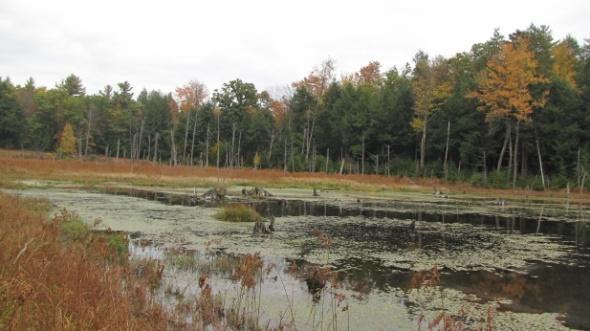Listing Status: Threatened (since 1997)
Global Status: Apparently Secure
Taxonomy
Kingdom: Animalia
Phylum: Chordata
Class: Reptilia
Order: Testudines
Family: Emydidae
Genus: Glyptemys
Species: muhlenbergii
Systematics
The family Emydidae includes approximately 95 species in 33 genera. Members are distributed throughout North America, northern South America, Europe, northwestern Africa, and Asia (Harding 2002).
The genus Glyptemys comprises two species: G. muhlenbergii (bog turtle) and Glyptemys insculpta (wood turtle). The wood turtle is also a species of conservation need, though wood turtles, unlike bog turtles, are not listed as threatened or endangered either at the federal level or in PA. Because a substantial portion of the world’s breeding population of wood turtles occurs within the state of PA, the state has a significant stewardship responsibility for this species. The global status of the wood turtle, like the bog turtle is Apparently Secure (G4, NatureServe 2009).
Ecology
Geographic Range
Two separate geographical populations of bog turtles are recognized.
1. Northern Population: NY, MA, CT, NJ, PA, DE, MD
Threatened
PA and NJ contain the highest number of extant bog turtle sites within the northern population. Bog turtles are limited in distribution to portions of 15 southeastern and eastern counties and possibly other isolated areas in northwestern PA.
2. Southern Population: VA, NC, TN, SC, GA
Threatened by Similarity of Appearance
Distribution of the Bog Turtle
Photo courtesy of U.S. Fish & Wildlife Services.
(http://ecos.fws.gov/speciesProfile/profile/species
Profile.action?spcode=C048)
Habitat
“The bog turtle is a habitat specialist that relies on early successional, groundwater-driven emergent wetlands.”
1. Early successional habitat: Sedges and other low herbs (meadows)
In PA, typically sedges, skunk cabbage, cattails, red maple, silky dogwood, alders, and willows
2. Persistent groundwater discharge
3. Saturated soil/mud: 7.5-10 cm deep to facilitate burrowing
In PA, typically a saturated mineral soil
Diet and Predation
Diet
Bog turtles are omnivorous and mainly consume insects, slugs, worms, frogs, salamanders, Carex seeds, Japanese beetles, berries, cattails, skunk cabbage, snails, and carrion.
Predation
Main predators include raccoons, skunks, dogs, and foxes. Bullfrogs, snapping turtles, water snakes, egrets, herons, crows, birds of prey, mink, and muskrats are also potential predators of bog turtle eggs, hatchlings, and adults.
Reproduction
Breeding occurs from late April through early June, but in PA, nesting is generally observed from June through early July. The female lays one clutch of eggs per nesting season and may only nest once every two or three years. On average, three eggs per clutch are observed. The eggs are deposited within a sedge hummock of sphagnum mat, or in soft soil above the water line; hatchlings typically emerge after 45-65 days. Heat and humidity are required for proper incubation of the eggs, but it is unknown if the species exhibits temperature dependent sex determination. The bog turtle’s life span is approximately 40 years. Bog turtles are reported to hybridize with spotted turtles, which are similar in size and overlap in habitat preferences.
Threats
Primary factors
1. Wetland habitat loss, fragmentation, and degradation
2. Illegal collection and trade
Secondary factors
1. Predation
2. Small, isolated nature of remaining colonies
Management
Restore bog turtle distribution through protection of extant populations.
1. Focus on watersheds that contain multiple occurrences of bog turtle in wetland systems that are dynamic
2. Conduct searches for new populations
3. Aggressively halt illegal collection and trade
Ensure the long-term viability of this species
1. Investigations into bog turtle landscape scale requirements and land-use management
2. Stewardship programs that attempt to balance human uses within the bog turtle’s agricultural wetland landscape
References
Barton, A.J. & J.W. Price, Sr. 1955. Our knowledge of the bog turtle, Clemmys muhlenbergi, surveyed and augmented. Copeia 1955:159-165.
Ernst, C.H., J.E. Lovich, & R.W. Barbour. 1994. Turtles of the United States and Canada. Smithsonian Institution Press, Washington, D.C., USA.
Harding, J. 2002. Glyptemys muhlenbergii: Bog Turtle. University of Michigan Museum of Zoology. <http://animaldiversity.org/accounts/Glyptemys_muhlenbergii/>. Accessed 18 April 2015.
Hulse, A.C., C.J. McCoy, & E.J. Censky. 2001. Amphibians and Reptiles of Pennsylvania and the Northeast. Cornell University Press, Ithica, New York, USA.
NatureServe. 2009. Version 7.1. Nature Serve Explorer: an online encyclopedia of life. NatureServe, Arlington, Virginia, USA. <www.natureserve.org/explorer>.
Nemuras, K.T. 1967. Notes on the natural history of Clemmys muhlenbergi. Bulletin of the Maryland Herpetological Society 3:80-96.
Somers, A.B., K.A. Bridle, D.W. Herman, & A.B. Nelson. 2000. The restoration and management of small wetlands of the mountains and Piedmont in the Southeast: a manual emphasizing endangered and threatened species habitat with a focus on bog turtles. Natural Resource Conservation Service. < https://boglearningnetwork.files.wordpress.com/2014/11/2000-somers-et-al-the-restoration-and-management-of-small-wetlands-of-the-mountains-and-piedmont-in-the-southeast.pdf >. Accessed 19 April 2015.
Steele, M. A., M. C. Brittingham, T. J. Maret, & J. F. Merrit, eds. 2010. Terrestrial Vertebrates of Pennsylvania: A Complete Guide to Species of Conservation Concern. The John Hopkins University Press. Baltimore, Maryland, USA.
U.S. Fish and Wildlife Service. 2001. Bog Turtle (Clemmys Muhlenbergii), northern population, recovery plan. Hadley, Massachusetts, USA.

No comments:
Post a Comment